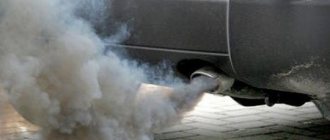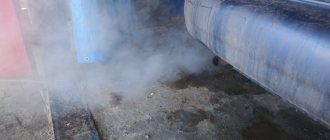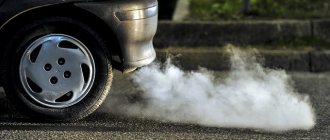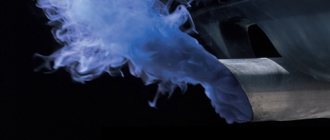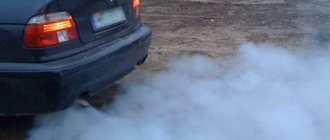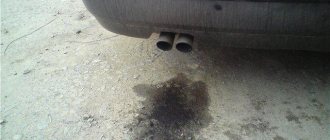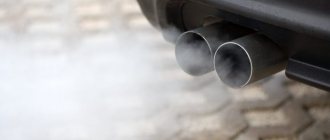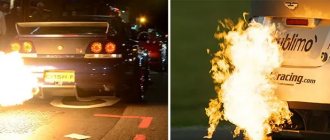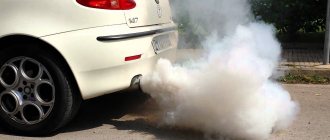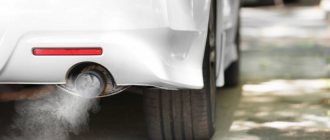Diesel engines are significantly different from gasoline engines. But the problems with them are almost the same as with gasoline units. After reading car forums, you can see many different topics where certain problems are discussed. But you can especially often see topics where car enthusiasts complain that diesel engines periodically emit black smoke from the exhaust. Let's figure out what the problem is and why this phenomenon occurs. Let's also see how this problem can be solved.
Making a diagnosis based on exhaust colors
Diesel engines, as well as gasoline engines, can have exhausts of various colors. More often it is white, bluish, gray and black smoke.
Let's start with white. Often white is the name given to smoke with a bluish tint. This happens when the turbine is destroyed and the lubricant gets directly into the intake tract. In such a situation, bluish smoke pours out of the chimney. But an inexperienced car enthusiast will easily mistake it for white smoke. And if you smell it, then it’s immediately clear and understandable what the reason for its appearance is.
Many people have burned vegetable oil or butter in a frying pan at least once in the kitchen. The smell is about the same. This smoke can also be confused with steam, which is more often observed in the winter months from the exhaust of not only diesel cars. It's all because of the water that appears as a result of combustion.
Later, after the engine has warmed up, the steam will not be noticeable, although it will not go away. This can be easily checked. You just need to place your palms near the exhaust. The palm will be slightly damp. This steam causes significant inconvenience when tuning the engine, especially in winter. For high-quality settings, you have to warm up the unit for a long time. And in cold weather the adjustment may not be possible at all.
Other causes of smoke in diesel engines
- Malfunction of the CCVV (crankcase ventilation valve). This problem is typical for BMW cars. When accelerating hard, the diesel produces thick white smoke. Replacing the valve solves the problem.
- Engine oil overheating. The problem manifests itself under extreme loads on the engine (full weight load, prolonged ascent) - then thick white smoke pours out of the muffler. The solution is to replace the oil with a higher quality one and not subject the engine to overload.
- Worn or hardened valve seals. The problem is typical for domestic cars with a diesel engine. It manifests itself as an abundant emission of white-blue smoke in the first seconds after starting the engine. As it warms up, the smoke goes away. The solution is to replace the valve stem seals.
Repair
If you find a crack in the cylinder head, then we can only recommend replacing the head. However, prices... Therefore, many car enthusiasts do not disdain contract details. These are used parts from Europe.
Cracked cylinder heads can be repaired, but we will not recommend this technology, because during such repairs a hole is drilled that will fit into the crack, and then a copper rod is pressed into the hole. There will be no blow-by, but one of the cooling valves will be blocked halfway. Such a head will have a significantly reduced resource.
Anti-smoke additives - a panacea or a waste?
Various auto chemical brands offer special additives to reduce oil consumption. They form a film on the rubbing parts of the engine that protects them from wear and fills existing microcracks. The use of additives replaces the decoking of piston rings, cleaning them from dirt. Manufacturers promise all this, but is it really so?
On auto forums you can find conflicting opinions about anti-smoke additives. Some auto mechanics note that the use of such products makes it difficult to overhaul the engine. The engine parts are covered with an oil layer, which is very difficult to completely wash off. Individual parts that could simply be cleaned have to be replaced, which means repairs are more expensive.
The additive only slightly extends the life of the engine before repair, but does not guarantee its trouble-free operation.
Blue smokes
For those with smoke pouring out of the exhaust pipe, diesel made them worry at the sight of blue smoke.
Blue, and on some engines it can be gray, on a working engine it is often caused by late injection. This problem has been mentioned more than once; many car enthusiasts have managed to discuss this topic up and down.
Experts say blue smoke is not scary. In most cases, the problem of late injection is associated with the natural process of wear of the fuel injection pump, naturally, if no one touched the pump.
Common Rail and Pump Duse systems smoke what to do
Use the Systempflege Diesel additive, which contains chemical components that provide highly effective cleaning of Common Rail and Pump-Duse fuel systems, as well as reliable protection of fuel lines and other parts of fuel equipment from premature wear due to the accumulation of solid and oily contaminants.
Possessing anti-corrosion properties, the product helps to extend engine life due to its ability to bind and eliminate water inclusions in diesel fuel, while simultaneously increasing its lubricating characteristics. Recommended for use in diesel engines of KIA cars and models of other brands with Common-Rail and Pump-Duse fuel systems.
Systempflege Diesel additive every 2-3 thousand km. mileage is poured into the fuel tank at the rate of 250 ml per 70 liters. diesel fuel
2. Cleaning of Common-Rail and Pump-Duse fuel systems can also be done using Pro-Line Ansaug System Reiniger Diesel flushing, described above.
For all injection systems
Diesel additive Diesel Russ-Stop fuel for reducing the smoke level of diesel engines has pronounced non-stick and anti-corrosion properties, providing reliable protection of injector needles and preventing the formation of soot and rust on all elements of the fuel supply system.
At the same time, the Diesel Russ-Stop additive increases the calorific value of the fuel, making the soot combustion process more active, due to which the product is indicated for use to prevent smoke formation. It is especially recommended for use in used engines of cars of previous generations.
For all stationary diesel engines and vehicle engines, including cars and trucks (except for those equipped with a particulate filter), agricultural and road-building special equipment. The additive is added to the fuel tank at the rate of 150 ml. for every 50 l. diesel fuel
Causes of Blue Smoke
The high pressure fuel pump in our conditions works as follows. The set of parts in this assembly constantly rotates, works, and rubs. And lubrication is provided by the pumped diesel engine. As long as the diesel engine is moderately oily, the pump can operate in this mode for a very long time. But when cold weather sets in, winter diesel fuel is poured into diesel fuel tanks. Everything about it is excellent, but there are no lubricating fractions at all. Well, or almost absent. All its fat content, along with various paraffins, was removed at the oil refinery.
So, when winter comes, most diesel injection pumps operate without lubrication and are subject to severe wear. Because of this completely natural, but already too rapid and increased wear, the injection advance is reduced. Diesel fuel stops heating and the cylinder stops working normally. The engine jerks and shakes. Fuel that does not have time to burn ends up turning into blue smoke. Some engines produce black smoke from the exhaust. If the engine is warmed up, then it will stop smoking, or at least the amount of exhaust will decrease. In this case, the fuel has time to warm up and ignite.
If the power unit has low compression characteristics, then the temperature in the combustion chambers is lower than necessary. And the fuel will not ignite. If the unit is equipped with a pair of cylinders with good compression, the cylinder with less compression will not work.
This picture often happens in parking lots. The cars are trying to start, and the entire area is filled with blue smoke. But sometimes diesel produces black smoke from the exhaust pipe. After warming up, the smoke will disappear. After all, the temperature in the engine is rising, and the temperature increase even in worn-out cylinders will be enough for ignition.
How to determine the cause
Now that you know why a diesel engine produces black smoke, it is important to correctly determine the cause.
If the car owner does not understand engines at all, then it is better to take the vehicle to a service center to solve the problem. If the car owner knows the structure, characteristics of the engine, how fuel combustion occurs inside the engine, then he can deal with the problem on his own.
Air filter problem
Error P0171, P0172 will indicate a dirty air filter. It usually appears on the vehicle's dashboard. Fuel consumption increases.
When the air filter is dirty, fuel burns in vain. Therefore, a loss of vehicle power is possible.
Experienced mechanics recommend changing the air filter device every twenty thousand kilometers . If the car is operated in extreme conditions, on dusty roads, in quarries, then the air filter should be changed once every 10 thousand kilometers .
A case from one's life
Mechanics tell one story on this topic. The cylinder head gasket on the unit was replaced. After the engine was assembled, we discovered strong shaking at idle. After a couple of kilometers these vibrations stopped, and after a couple of minutes of idling the shaking reappeared. Mechanics analyzed this situation and found out that the new gasket was slightly thicker. Until the diesel engine warmed up to operating temperature, it did not work smoothly.
So, the main cause of blue smoke is late fuel injection and low compression performance. Many modern engines have a device that performs injection a little earlier. Cars work harder, but the fuel in the cylinders heats up and burns without smoke, that is, at all. Then the unit heats up, the coolant heats up the actuators, and they return the injection advance piston to its rightful place. The motor runs smoother and more pleasant.
Why does black smoke come out of a diesel exhaust pipe?
A larger volume of supplied fuel is usually a signal of either incorrect adjustment of the fuel injection pump, wear of the injectors, or wear of the speed controller in the pump.
Any fuel pump is equipped with a special adjusting screw. It is used to adjust the volume of supplied fuel. With this screw you can only roughly adjust the volume. If this screw is tightened, then the volumes increase. And where there is an increase in volumes, there is also an increase in idle speed. But the speed can be significantly reduced. Then you can increase the power. But black smoke from the exhaust pipe will continue to drive diesel. If the adjusting screw on the fuel injection pump is screwed in even more than it should be, the unit will practically stop reducing speed.
The saddest thing
One of the saddest breakdowns that beset diesel owners is the inevitable wear and tear of the fuel pump. As already mentioned, the guts inside the pump operate without lubrication. While diesel still lubricates something in summer, in winter it doesn’t. And domestic fuel is generally of low quality. This is where the insides of the pump wear out.
When the gas pedal is pressed very sharply, for example, in order to quickly move off, the injection pump lever is switched to increase the volume of fuel supply. This lever will rest on the support. And the position of this very support has already been adjusted by the regulator. Therefore, it will not be possible to increase the volume too sharply. So, by pressing the pedal, the driver only wants to give a larger volume of fuel. And it’s not at all a fact that this will lead to an increase in turnover. This directly depends on how worn the speed controller is. If it is in normal condition, then the car will start with gray smoke. If the wear is large, then the diesel will spit out black smoke from the exhaust pipe in a large cloud.
About lack of air
Also, dark gases from the pipe can sometimes be caused by a lack of air. But in this case, the exhaust will not be black, but rather gray or dark gray. At the same time, a decrease in power is observed.
This can be caused by a clogged air supply filter. This is by no means a rare case, and it happens to everyone from time to time. It has been proven not 10 or 100 times by bitter experience that only 15 minutes in a traffic jam in front of a KamAZ truck with black smoke coming out of the exhaust pipe is enough. The diesel is burning, and the new filter of the one standing behind can now be thrown into a landfill. But this happens if KamAZ’s fuel system is incorrectly adjusted, although no one has it adjusted.
Also, a lack of air can be observed due to incorrect operation of the EGR and throttle valve, incorrect clearances in the timing valves. Also among the reasons may be incorrectly set gas distribution marks, turbine malfunctions.
When the car is equipped with a turbine and you see black smoke from the exhaust pipe of a diesel turbo, then it is worth checking the boost. Most likely, that's the problem. It is also worth looking for cracks in the fuel or air system pipes.
One of the car owners poured fuel system cleaner into the car. After driving for a while, at high speeds when driving uphill, the car began to puff out black smoke. But after puffing a little, the smoke disappeared and has not appeared since then. At the same time, he checked all the above reasons. He believes the additive helped. The car didn't smoke anymore. So, perhaps the cause of the smoke in this case may simply be soot from the fuel system, especially if the diesel engine is equipped with a converter. Sometimes the filter needs to be cleaned from time to time.
Consequences of soot formation
Once black exhaust ceased to be a characteristic of this type of engine, but began to indicate a malfunction, the consequences became impossible to ignore.
Failure to eliminate the causes in a timely manner will lead to higher costs for inevitable repairs:
- the particulate filter will overload and fail;
- soot will clog the exhaust system, turbine and EGR valve;
- carbon deposits will penetrate into the oil sump and damage the lubrication system;
- in addition to soot, the oil will be diluted with liquid fractions of unburned fuel, which will deprive it of its programmed properties and will lead to accelerated wear of the cylinder-piston group and the crankshaft with bearings and connecting rods;
- the thermal regime of the motor will be disrupted, overheating will lead to breakdowns and deformations of parts;
- the gas distribution mechanism, primarily the valves, will become unusable;
- the engine will reduce power and increase fuel consumption.
The possibility of self-repair is very limited; the simplest diesel engines are no longer produced, and in modern ones you can only change the fuel and air filter.
Everything else will require contacting specialized enterprises that service diesel engines.
Another reason for black smoke from a diesel exhaust pipe
One of the owners of a diesel car suddenly began to smoke. During the autopsy, nothing intelligible could be found. But after reading all kinds of forums and talking with other diesel owners, it turned out that the problem was in the ignition.
After opening it again, a control valve was found on the ignition unit. He was advised to hit the adjusting bolt. After that the car stopped smoking. It turned out that it was the ignition angle solenoid valve.
When the ignition is turned on, a working sensor crackles. What to do if black smoke appears from the exhaust pipe (diesel)? No matter what ignition it appears, the sensor should be removed. If the engine has stopped smoking and the car is running smoothly, then it’s time to change this element.
Black smoke and cold start
A study of the forums showed that many people complain about smoke when starting a diesel engine when cold. Some people say that this is a fuel injection pump, but more experienced car enthusiasts say that this is not so.
It is believed that this phenomenon is quite normal. Usually it is short-lived. This can be explained by the fact that during a cold start, an over-rich mixture is supplied to the cylinders. Hence the black smoke from the exhaust pipe. Diesel often does this when cold. Therefore, there is no need to panic about this.
The situation with the Kia Sorento
Let's give a specific example. One of the owners of this car produces thick, black smoke when pressing the accelerator pedal. When moving, the car is very reluctant to gain momentum.
A scan was carried out for possible errors in the electronic system, but there were no errors. Analysis of the operating parameters also did not give the desired result. At first glance, there is simply no defect. The balance of the injectors is in normal condition, no serious deviations were noticed, the turbine produces a normal level of pressure, but the Kia Sorento diesel still produced black smoke from the exhaust pipe. When measuring the readings, we thought about the USR. This is a valve that regulates exhaust gases.
After examining it, they discovered serious soot deposits behind the throttle valve. After removing the exhaust gas pipe, soot and oil were also found in the intake tract. In the end everything was removed and cleaned. But a more detailed examination of the valve itself revealed damage to its seat. As a result, the valve was replaced.
As a result, there is no smoke, and the car drives noticeably better.
avtoexperts.ru
During engine operation, combustion products are released in the form of heated exhaust gases. The color of the exhaust, in this case, can be different, depending on the completeness of combustion of the air-fuel mixture, as well as the state of the ignition and power systems. The opaque gases coming out of the exhaust system can have three shades of color: white, blue and black.
Reasons for changes in exhaust color
The appearance of one of these shades in exhaust gases is possible on both gasoline and diesel engines.
Especially the color of the exhaust gases of diesel engines can change shade due to a failure when installing the injection point of the injection pump (high pressure fuel pump). Diesel engines are generally very critical when it comes to injection installation, which immediately affects the color of the exhaust.
On gasoline engines, the color of exhaust gases may change if adjustments in the power supply system, ignition system fail, or if the CPG (cylinder-piston group) malfunctions.
Diesel:
• White smoke – when self-ignition is delayed (late ignition or, more precisely, late setting of the fuel injection point), can also be observed when the engine warms up, when the cylinders have not yet warmed up enough for timely ignition of the fuel;
• Black smoke – early fuel delivery, a boost malfunction, or accumulated dirt in the intake manifold.
The appearance of a black exhaust color is also possible when the gas pedal is sharply pressed (on turbo engines), when the turbine corrector enriches the fuel supply, but the turbine has not yet accelerated from its inertia due to lack of air;
• Blue smoke – problems with fuel atomization. This is the most dangerous situation, since further operation with such a malfunction ultimately leads to engine failure and, as a consequence, complex and expensive repairs.
The appearance of blue exhaust gases is possible when a large amount of oil enters the combustion chamber due to a high oil level, or wear of the CPG, or valve guides and their valve stem seals.
Gasoline engines:
• White smoke – when the head gasket is broken or a crack appears in the body of the head in the area of the combustion chambers) when the coolant enters the cylinders, where it boils due to the high temperature from the combustion of the air-fuel mixture;
• Black smoke is a consequence of fuel over-enrichment. This may be caused by faulty injectors, a dirty air filter, or late ignition;
• Blue smoke indicates the presence of oil in the exhaust gases. The reason may be either wear of the piston group, breakage of rings or partitions on the pistons, or wear of valve guides and valve stem seals. Blue smoke can also be caused by an increased oil level in the engine sump.
Trouble-shooting:
• Precise setting of the fuel injection angle, which is recommended to be done in specialized car services where there is appropriate equipment and professional mechanics;
• Timely engine diagnostics to eliminate faults at an early stage.
• Replacing the head gasket, grinding the head plane and testing it if there is a suspicion of a crack in the cooling jacket;
• Washing of injectors and their adjustment on a special stand with a selection of faulty ones;
• Repair of the CPG (replacement of piston rings, pistons) or cylinder head.
Examples from the “life” of engines
From the practice of engine maintenance and repair, often the cause of block gasket breakdown is its unprofessional replacement. As a rule, the head fastening bolts are tightened either with a large torque or with an insufficient one, since the work is performed without using a torque wrench, or one that has not passed the next verification.
When tightening the head mounting bolts, its plane becomes warped, as well as the body of the bolts is stretched, which can “shoot” at any moment or release on its own. In any case, when replacing the block gasket, it is necessary to check the plane of the block head and mill it, which is required in almost 99.9% of head inspections.
Insufficient tightening torque of the head mounting bolts leads to secondary breakdown and repeated engine repair.
Branded gaskets always come with an insert indicating the torque and tightening order of the bolts that secure them, which must always be adhered to, plus carry out the work with a verified torque wrench.
On diesel engines, the cause of the appearance of white or black smoke may be the milled plane of the cylinder head above the permissible marks. This leads to the fact that the mechanic cannot accurately set the fuel supply angle, since the height of the cylinder head has changed and the timing drive (chain or belt) is not installed according to the factory marks.
Plus, there is a slight (not critical for engine safety) contact of the valves with the piston bottoms, which they try to eliminate by installing an additional head gasket, which does not always help and in the end it is necessary to replace the cylinder head itself due to the negligence of those who milled the head plane.
In conclusion, it is worth adding that in a normally adjusted engine, with working compression in the cylinders, be it a gasoline or diesel engine, the exhaust does not have any pronounced color and is practically invisible.

